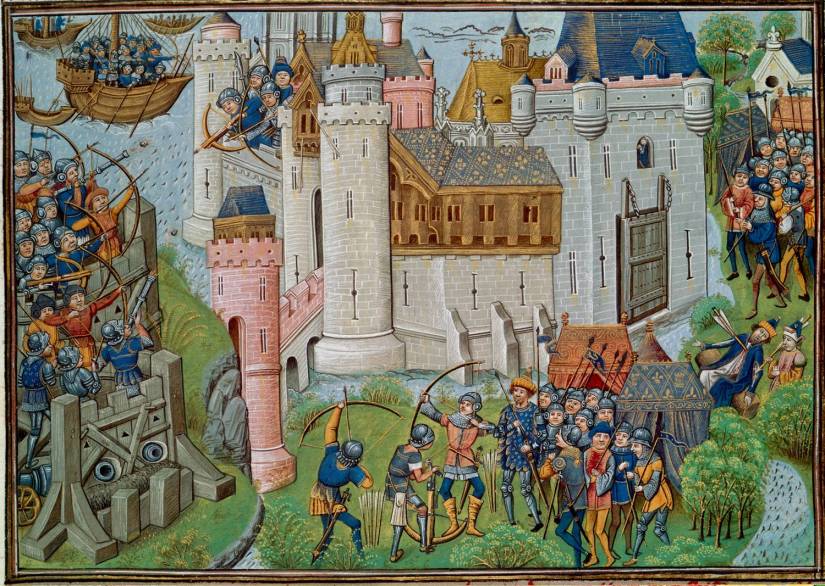In 1378 a Mercenary Captain fighting in the Hundred Years War was assassinated. His name was Owain ap Thomas, and he was a Welshman fighting for the French against the English, and his assassination was ordered by the English Crown.

[Owain is on the right falling backwards – his assassin, John Lamb, is behind him].
This might sound a sub-plot from ‘Game of Thrones’, but this was all very real and had repercussions which we are only just really beginning to understand in terms of the history, archaeology, literature and art history of this particular man.
Owain ap Thomas was also known as Owain Lawgoch or Yvain de Galles. His career as a mercenary captain in France, Switzerland and Guernsey, lasted from what the documentary sources can tell us from 1363 to 1378. He was buried in the nearby chapel dedicated to St.Leger, and his mercenary company continued on, fighting for the French Crown without him.
The story of Owain ap Thomas was written about by in A.D. Carr (1991). Owen of Wales: The End of the House of Gwynedd. University of Wales Press. ISBN 0-7083-1064-8. Copies are hard to find, but if you are interested in the period you should try and find a copy. The book identified the manors (consisting of a manor house and associated land) which Owain left behind when he went to France, and these were in Powys, Gloucestershire, Cheshire and Surrey. Inquisitions were held by the authorities in each of these places to find out when he had left and what property and possessions he had left behind.
The manor in Surrey was at Tatsfield (Latitude 51.287393; Longitude 0.029869080) and had been in Owain’s family for three generations. His grandfather Rhodri ap Gruffudd (brother of Llywelyn ap Gruffudd who had been Prince of Gwynedd until his death in 1282) had come into possession of the manor in about 1310, and it belonged to his son Thomas from 1315 to 1363.
I’ve been researching the archaeological evidence for the estates of Owain Lawgoch since 2004, and a paper on them was included in a book published in 2008 entitled ‘Mercenaries and Paid Men: The Mercenary Identity in the Middle Ages’. You can download a copy of the paper from http://works.bepress.com/spencer_gavin_smith/ The history of Tatsfield in the years after 1363 is for me, particularly fascinating. The manor itself ceased to exist as an administrative entity after Owain left, and it was handed over to the lords of the adjoining manor of Titsey (Latitude 51.278615; Longitude 0.014226437). They constructed a court house in Tatsfield to deal with the administration of the cases that happened there, but they continued only to live in Titsey.
I directed an excavation in Tatsfield in 2004, and the evidence from this and from the historical evidence I’ve also been able to research, suggests that the Manor House there was dealt with in the same way the Llysoedd were removed during the Edwardian Conquest (see https://medievalparksgardensanddesignedlandscapes.wordpress.com/2014/05/04/avengers-assemble-but-where/). The paucity of building materials left on the site suggested careful dismantling rather than simply pushing the building over and rendering it unusable. Doing this would leave a visible marker and a place where assembly could happen, and the proximity to London – only 20 miles to Westminster – would have been an even more potent and visible reminder than a series of castles along the north Wales coast.
